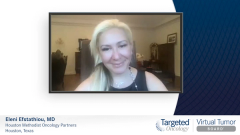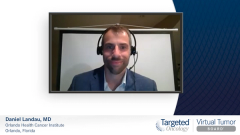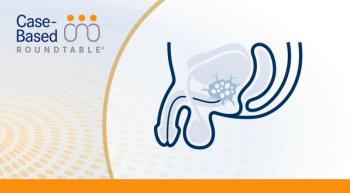
Optimizing Management of Nonmetastatic CRPC: Darolutamide Therapy
Comprehensive insight on darolutamide therapy in nonmetastatic CRPC, supported by clinical data from the ARAMIS trial.
Episodes in this series

Transcript:
Eleni Efstathiou, MD, PhD: Let’s go to [discussing] darolutamide’s difference from other agents in this class. There are 3 agents in the second-generation class, and you can already see even if you haven’t been involved with the agents as much, the completely different structure in darolutamide versus enzalutamide and apalutamide, which are essentially siblings and developed in the same laboratory. The difference, of course, is that apalutamide, and enzalutamide even more, so can penetrate the blood-brain barrier. Darolutamide is structurally distinct from the other two, and the blood-brain penetration is low or even nonexistent, I would argue. There are some data that are referred there that one can look further into. Now, as you mentioned, Alan, the phase 3 ARAMIS trial of darolutamide for nonmetastatic CRPC [castration-resistant prostate cancer] study design is essentially the same as the one for enzalutamide and for apalutamide. Men with high-risk nonmetastatic CRPC who had a baseline PSA [prostate-specific antigen] that was at least 2 [ng/mL] and a PSA doubling time of 10 or less months and were fit, with an ECOG [Eastern Cooperative Oncology Group] performance status of 0 or 1, were randomized to continue their androgen deprivation and have darolutamide added in the dose that we know, 600 mg orally twice a day, versus being randomized to ADT [androgen deprivation therapy] plus placebo given twice daily.
The primary end point, very importantly, is metastasis-free survival. This was across the 3 trials. Secondary end points were overall survival, time to first skeletal-related events, cytotoxic chemotherapy, safety, tolerability, quality of life, are all very important end points. These are the baseline characteristics of the patients, and I want to draw your attention to the median age. We are definitely looking at a median age that is geriatric, at 74, with a wide range, but look at that upper range, 95, enrolled on a trial, phenomenal. We treat such patients in our clinic with darolutamide. The median time from initial diagnosis was quite long. If we go down to the PSA doubling time, we can see that most men had equal or less than 6 months of PSA doubling time, so pretty rapid doubling time. Of course, you can see that they met the other criteria. For the metastasis-free survival primary end point, there was an impressive almost 2-year difference, 59% risk reduction of distant metastasis or death at a median follow-up of 18 months. Now, the overall survival was presented later as you recall. We see again at a median follow-up that is rather early, already a signal that meets significance, 31% reduction in the risk of death. The important part here that we all keep in mind is that all of these men upon progression are more than likely exposed to similar agents, so earlier makes a difference here, going back to that early CRPC that we were discussing.
Concerning treatment-related adverse events, which are reflective of quality, we do have on-target effects that are expected, and you [would] want to see them because you’re treating with an androgen receptor inhibitor, but their differences are small. You see there is about a 4%, 5% difference in fatigue. Yes, you would expect to see that, but usually, we see much more, so that is very reassuring there. There’s no difference in falls, which is good. We need to look more into that and understand whether darolutamide is more protective of peripheral events, apart from not penetrating the blood-brain barrier, which would be one cause of falls, also [whether] it leads to less muscle loss, things that I have a lot of interest in looking into. We can see that we don’t see any difference in bone fracture. Now, remember, darolutamide is a younger agent, so we don’t have enough information with regard to contribution to bone density loss and the like. I think with years, we’ll get more of that, but very interesting data. I like the fact that we don’t have a lot of weight decrease, unlike in the case of apalutamide where we did see weight decrease, which I thought originally was a good thing. However, it turned out to be muscle loss. These are very important data, especially if you are interested in the core of androgen signaling inhibition.
Here we’ve got a summary, just again to reiterate how similar the 3 trial designs are. This is a great thing because in a way, the one trial supports the other. It’s reproducibility of data, and I really love this. If we had any controversy, we’d have a different discussion. The design is very similar. The primary end point is exactly the same. The readouts of the primary end point are almost superimposable, and all 3 trials met the overall survival. Now you’ve got a ratio of efficacy versus safety, and that’s what your decision is based upon. Efficacy looks identical from where I’m standing. Of course, there can be little granular differences, but essentially, it’s going to boil down to safety. Let’s look a little at the safety, keeping in mind a caveat. SPARTAN was a trial where safety was assessed every month. The other 2 trials were every 4 months. We have to keep that a little in mind when we’re trying to interpret the data. But I think our focus should be the delta between the active agent and the placebo in each trial.
You can see here if you go where the red lines are, where we’ve underscored it, the differences in the fatigue, it’s more pronounced when it comes to enzalutamide and apalutamide, and less on the ARAMIS trial. We see the difference in hypertension that we know enzalutamide, a lot of people don’t look into it, can cause. We can see the difference that is unique to apalutamide with causing rash, 26% versus 6% in placebo, and almost no rash in the case of darolutamide and enzalutamide. And of course, the falls that are likely, as we said, related to the brain effect, but may have to do with muscle loss as well. And finally, the result of falls are the fractures. I think the safety is pretty convincing, we have to say it, to be in favor of darolutamide with full disclosure of not being involved in the development of the drug.
Transcript edited for clarity.












































